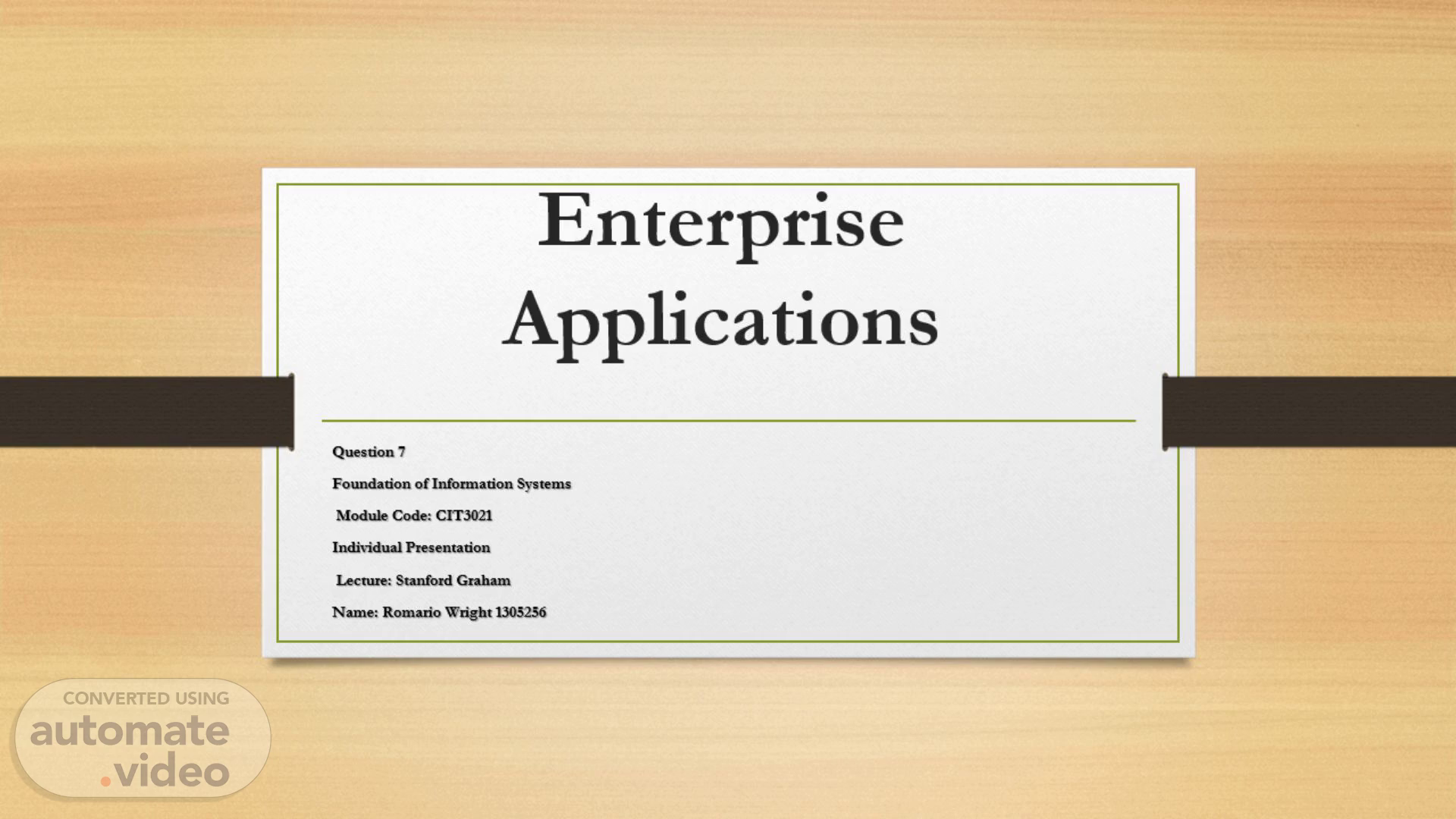
Enterprise Applications
Scene 1 (0s)
[Audio] Enterprise Applications Question 7 Foundation of Information Systems Module Code: CIT3021 Individual Presentation Lecture: Stanford Graham Name: Romario Wright 1305256.
Scene 2 (17s)
[Audio] Overview Systems for enterprise resource planning (E-R-P--) are essential for assisting companies in becoming more operationally efficient. Enterprise Resource Planning (E-R-P--) systems help integrate various components of essential business tasks into a unified platform streamlining daily workflows and procedures and providing a real-time view of the business (NetSuite.com). In addition to several additional aspects common to E-R-P systems and how they may be used to further enhance operations this article looks at the eight core components of E-R-P systems and how each one helps to simplify operations improve data management and foster tighter cooperation..
Scene 3 (1m 3s)
[Audio] 7 Main Components of ERP Systems Accounting & financial management Human Resources (H-R---) The accounting and financial management module in E-R-P systems ensures accurate financial insights across the organization enabling informed decision-making and streamlined operations. This integration minimizes errors allowing teams to focus on key tasks with current financial data for reporting and analysis. The HR component of E-R-P systems streamlines various HR tasks including recruitment hiring performance evaluation and payroll processing. It minimizes errors and duplication in managing personnel information while enabling strategic HR functions such as performance management and workforce planning through analysis of HR data..
Scene 4 (1m 56s)
[Audio] Customer Relationship Management (C-R-M--) Business Intelligence (B-I---) BI is now integral to E-R-P systems analyzing data to generate insights for data-driven decisions. Visual reporting aids trend identification while integrated solutions provide comprehensive data views for informed decisions across departments. C-R-M is a vital component of E-R-P systems storing and tracking customer and lead data for sales and marketing insights. It monitors purchase trends reduces duplication in lead engagements and enhances sales effectiveness. Integration with eCommerce software enables customer-centric benefits like secure payment processing and targeted advertising..
Scene 5 (2m 41s)
[Audio] Supply Chain Management (S-C-M--) Inventory Management E-R-P systems leverage real-time data analysis in inventory management within S-C-M optimizing inventory levels enhancing visibility and integrating financial and operational data for increased efficiency and profitability. Automation including demand forecasting improves control and minimizes errors. S-C-M capabilities within E-R-P components are essential for competitive supply chain management. They optimize processes facilitate real-time data collection and enable predictive analytics for demand planning. Effective inventory placement enhances profitability while C-R-M integration improves customer communication and delivery estimates..
Scene 6 (3m 28s)
[Audio] Manufacturing and Logistics Management Manufacturing and logistics management are integrated into E-R-P systems alongside S-C-M providing features like demand forecasting and production scheduling. E-R-P streamlines processes including production scheduling assembly distribution and order tracking. It simplifies bill of materials (B-O-M--) preparation by automating based on product designs enhancing accuracy and efficiency with standardized B-O-M templates and real-time version monitoring..
Scene 7 (4m 6s)
[Audio] Extending Enterprise Applications for Enhanced Value Improved Flow of Information Standardized Process Simple IT Infrastructure Workflow Automation.
Scene 8 (4m 17s)
[Audio] ERP: Fulton & Roark Retailer of men's grooming items Fulton & Roark found success with a quick E-R-P deployment. The firm which was hitherto dependent on spreadsheets and desktop accounting software encountered difficulties managing financial procedures and inventory monitoring as its sales grew quickly. Within three weeks of NetSuite E-R-P implementation processes were simplified manual data input was eliminated and accuracy increased. Reducing errors cutting off outside accounting services increasing sales significantly without hiring more people and improving margins and inventory control for growing e-commerce were among the main results. This scenario emphasizes how crucial it is to introduce E-R-P-s quickly and have strong management support in order to encourage employee adoption..
Scene 9 (5m 10s)
[Audio] Reference NetSuite.com. (n.d.). 8 main components of E-R-P systems. Oracle NetSuite. netsuite Hayes K (2024 January 22). E-R-P components: Core Parts to Enterprise Resource Planning. SelectHub raquo. selecthub What is the most important benefit of an enterprise application?. BinarApps. (2022 May 16). binarapps NetSuite.com. (n.d.-a). 3 companies 3 successful E-R-P implementations. Oracle NetSuite. netsuite.